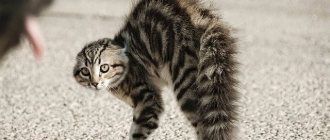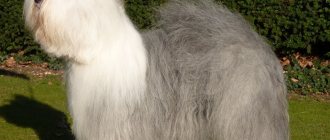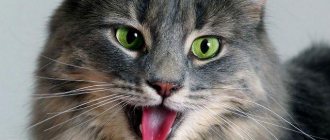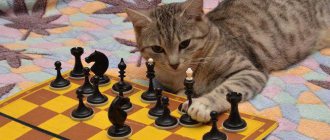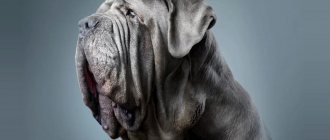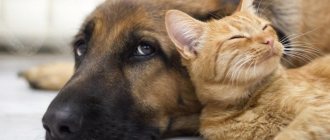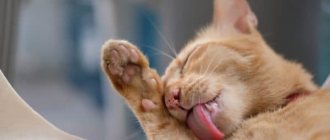Of course, you have wondered why our pets lick our faces, hands, and feet. Are they doing it just out of sympathy? Or perhaps other reasons? It turns out that there can be many reasons for this behavior. So why does a dog lick a person, and also tell you how to cope when the licking becomes unpleasant.
Most of us love it when a pet jumps onto the sofa cheerfully and joyfully, wagging its tail and starts licking its hands or face. Moreover, we often allow this behavior ourselves. We tenderly lift the puppy up, allowing him to lick our face. The problem starts when the dog gets older and we can't handle him.
Dog kisses
For many dogs, licking their owner is a kind of greeting ritual and a sign of worship. Thus, the animal expresses the joy of spending time together. And it doesn’t matter here whether they know this person or see him for the first time in their life. Because of this, we should not punish a dog for licking or reject the pet's friendly intentions.
However, if you are worried about the intrusiveness of your four-legged friend, then we will tell you how to deal with it so that your pet does not perceive it as a punishment. There are also theories that dog owners mistakenly believe that licking is a sign of affection. In the world of wolves, licking each other is a signal associated with different needs and the presentation of the individual's place in the group.
You are awesome
Dogs in the human family have a hierarchy between family members. This is due to genetic predisposition and descent from wolves. In a pack, the weak ones show submission to the dominant individuals, in particular, by licking. This is a sign of respect. If a dog licks only one person in the house with particularly high frequency, it may mean that he considers him the leader. Often this is a person who regularly gives the four-legged animals food. As a result of group hierarchy, the animal licks when you scold it. This is a prototype in wolf fights. Licking showed respect to the winner. Your dog may react this way when they are unhappy or irritated. Suitable to show you my respect.
Why does a dog lick its face?
Licking the owner's face is especially common among puppies and young dogs. This behavior is associated with the period of stay with the mother. When the time for sucking milk ends and the exploration of solid food begins, the bitch first dispenses food directly from her mouth. Hungry babies, demanding another portion, lick their mother's face. Many puppies, having begun a new stage of life in the human family, try to ask for food from their owner in the same way.
Dog hygiene
Dogs living in a group, just like wolves in a pack, lick each other to help maintain cleanliness. Bitches lick puppies with special care. Therefore, it is completely natural for four-legged animals to behave this way and show concern for other members of the pack. It often happens that adult dogs lick the face and ears of small children. And they are treated as weaker people who need to be taken care of, and hygiene is a manifestation of care.
Why does a dog lick his hands?
Do you return home and the dog starts sniffing you and licking your hands from the doorway? Which has not been surprising for a long time. There are many unknown smells and tastes on clothes and bodies after being outside. This is an ideal way for a pet to get to know them. Some dogs, in turn, have strange taste preferences, which may be the answer to the question “why does a dog lick a person’s feet?” As you know, human sweat has a specific smell and salty taste. An animal, feeling the sweat on human feet, cannot resist the temptation to lick them.
Pay attention to me!
It also happens that a dog licks its owner... out of boredom. This is a form of attracting attention to oneself, fun and general activity. Neglected pets look for different ways to get us to pay attention to them. A pet may lick its hands as a sign that there is too little motor or mental stress. Provide him with enough time to go for walks together - this is the basis. Also take care of his mental development. Regular team training and learning new tricks will bring only advantages to your pets. You can also use toys filled with delicacies, especially when you know that you are leaving it for a long time when you go to work.
photo source
To allow or not to allow? That is the question
You probably asked yourself the question: is it okay to let a dog lick me? If you like it, then we see no contraindications. On one condition... That your pet does not lick your face. Dog saliva and the pathogens it contains are quickly absorbed through the mucous membranes of the nose, eyes and mouth. It is true that diseases transmitted from dogs to people are rare, but there is no need to increase this risk. Do not allow licking of hands or other parts of the body if there are lesions on the skin.
Many people are of the opinion about the medicinal properties of dog saliva. It’s as if the animal’s saliva contains antibiotics that are designed to fight certain bacteria. However, scientists from Philadelphia note that dog saliva only has a cleansing effect on a dog's wound.
How to stop a dog from licking?
You already know that dogs wash their owner, not only because of love, but also for other reasons. If this method of communication is not very suitable for you, you can try to wean your pet from licking. First of all, start ignoring this behavior. Hide your hands behind your back while saying the command “no.” At the same time, remain calm.
Avoid pushing the dog away and do not shout. If you haven't stopped him from licking you so far, the dog will be confused by the sudden change. Moreover, on the contrary, he may lick you to show submission. Redirect your dog's attention to another activity for which he could be praised.
Let him follow the command, for which he will receive a treat. The pet will remain in the comfort zone, and at the same time lose interest in licking. It is important that the whole family takes part in weaning the dog. If other family members allow the dog to lick, and even encourage it, then the whole process will end in a fiasco.
Dog kisses, yes, but in moderation
Now you know why a dog licks its owner. There may be several reasons depending on the situation. Most people support this way of showing affection or interest on the part of their pet, and some even expect this behavior. Remember, do not let anyone lick your face, and wash your hands thoroughly after touching your pet. Even if you care about your pet's health, you never know what your pet may come into contact with during its daily walks.
Interesting for you:
In someone else's skin
To be able to recognize the essential elements of an animal's umwelt is, in essence, to become an expert on ticks, dogs, people, and so on. This is how we can close the gap between what we think we know about dogs and what they really are.
We can try to assimilate the umwelt of another animal, to incarnate into the animal (bearing in mind the limitations imposed by our sensory system). It's an amazing thing to spend a day being as tall as a dog. Sniffing (even with our less-than-perfect noses) the objects we encounter throughout the day fundamentally changes the way we think about familiar things.
Now pay attention to the sounds in the room where you are - sounds that you are used to and that you do not usually listen to. So, with some effort, I hear the noise of a fan in the corner, the hum of a truck in the distance, the inaudible voices of people climbing the stairs; a wooden chair creaks under someone; my heart is beating; I swallow; The page rustles as it turns. If my hearing had been sharper, I might have heard the scratching of a pen on paper at the opposite end of the room, the sound of a flower growing and the insects talking under my feet. Perhaps other animals hear these sounds clearly.
Gratitude for caring: a pet licks his hands when he is petted or fed
If a cat licks its owner’s fingers, most likely this is his way of expressing gratitude to him for affection or a tasty treat. If people have many means to express their feelings (words, looks, gestures), then representatives of the cat family have little choice.
Probably every cat owner has noticed that when you pet or treat your pet with something tasty, he begins to look into his eyes. Some of the cats, in a fit of strong feelings, also lick. You shouldn’t push away an overly loving animal; let him fulfill his “duty” to the end, because for him licking his owner is a sincere impulse in response to kindness.
The meaning of things
Different animals see objects around them differently. A dog who looks around the room does not at all consider himself surrounded by a person’s things - all these are objects of his world. Our ideas about what this or that object is intended for may or may not coincide with a dog’s. The meaning of things is determined by what we do with them (von Uexküll called this “functional tone”). A dog may be indifferent to chairs, but if you teach him to jump on them, the chair becomes something to sit on. Subsequently, the dog may independently discover that there are other things intended for sitting: a couch, a pile of pillows, or, for example, a person’s lap.
So, we begin to understand in what ways the ideas about the world of dogs and humans are similar and in what ways they are different. For dogs, many objects in the surrounding world are associated with food - much more than for people. Moreover, they distinguish “functional tones” that do not exist for us - for example, things that can be tastefully rolled on. If we are not children and are not inclined to such games, then the number of such objects tends to zero for us. And on the contrary, a huge number of things that have a strictly defined meaning for us (forks, knives, hammers, pushpins, fans, watches, etc.) have no (or almost no) meaning for dogs.
So, there is no hammer for a dog. It means nothing to her, at least until it is associated with another, meaningful object (for example, the owner uses it; the cute dog who lives down the street urinated on it; it has a wooden handle that can be chewed on).
When the umwelts of a dog and a person collide, then, as a rule, people do not understand what their pets are doing. For example, a person quite seriously states that his dog knows that he has nothing to do on the bed. A person can even buy a special dog bed and order the dog to go lie down there. Usually the dog obeys. The person feels satisfied. Still, another step towards mutual understanding has been taken.
But is it? Many times, returning home, I found a crumpled, still warm bed and realized that either my dog had just been lying there, joyfully greeting me on the threshold, or some unknown invisible alien. We easily formulate: a bed is intended for a person, a dog bed is for a dog. A human bed is a place to rest and may contain expensive linens and a variety of pillows. It wouldn’t even occur to us to sit on a dog bed that cost us (comparatively) little and is strewn with chewed up toys.
What about the dog? She doesn't see much difference between her bed and ours, but ours is much more attractive. After all, a bed smells like a person, and a dog bed smells like something that the master happened to have at hand. The bed is where we spend some time; Sometimes there are crumbs scattered and clothes lying around. Of course, the dog will prefer our bed to his bed! She doesn't know why we perceive this place differently. Of course, a dog can remember that a human bed is something special if he is regularly scolded for lying on it. But then he will understand not the difference between his bed and our bed, but rather the difference between the places where he can and cannot lie unhindered.
In the dog world, a bed does not have a “functional tone.” Dogs sleep where they can, and not where we would like them to. For relaxation, they choose places where they can lie down comfortably, where it is not hot or cold, there are relatives and it is safe. Almost any flat surface in the house meets these requirements. Design a corner to suit your dog's tastes, and your pet will likely find it just as desirable as a bed.
How to break your pet's habit
When an owner is annoyed by such excessive attention from his cat, there are several ways to try to get rid of this habit:
- A game. By switching attention to entertainment and giving your pet an outlet for energy, you can relieve her for a while from the desire to lick something or someone.
- Weasel. If the problem is stress or lack of attention, you need to pet and hug the animal more often, and the problem will disappear soon.
- Change of interests. Apply a special solution – catnip – to your pet’s toys. It is sold in pet stores. Its scent will attract the cat's attention.
- Refusal. If your pet's behavior becomes overly intrusive, every time he tries to lick him, you need to gently but decisively push him away and make it clear that this is not worth doing. After some time, the method will work and the cat will stop trying.
- Substitution for another item. Buy a fur mitten and put it on your hand every time you try to lick your fingers. After time, attention will switch to the object, and the owner will no longer be needed.
It is worth remembering that such behavior of a pet can be due to a whole range of different reasons and there is no need to get angry or scold him for it. After all, with such behavior the cat does not want to cause harm, but is simply trying to attract the owner’s attention to his person or show love.
Owners of domestic cats who have several pets at once often note that their pets lick each other. This behavior of cats causes emotion in humans, but the question also arises of why animals behave this way.
From a human point of view, such a manifestation of feelings means affection. Animal psychologists still have not given an exact answer why cats lick each other, because this is not only a manifestation of love, everything is much more complicated. Such licking is characteristic not only of cats, but also of monkeys, as well as wild felines.
Dog "kisses"
For Pumpernickel, kissing is a way of establishing contact; so to speak, a hand extended to me.
Pumpernickel licks my face when I get home and lean over to caress her. She licks my hand to wake me up when I start to doze off in the chair. She carefully licks my sweaty feet after running. Sitting next to me, Pumpernickel presses my hand with his front paw, unclenches his fist with his nose and licks my palm. I am delighted.
I often hear dog owners testify to their pet's love through the "kisses" their dogs give them upon returning home, be it slobbery "kisses" on the face or thoughtful "polishing" of a hand with the tongue.
I consider Pumpernickel kisses to be a sign of affection. “Affection” and “love” are not recent inventions of our society, which considers dogs to be little people who should be dressed up in bad weather, pampered with trips to the resort and dressed up for Halloween. Charles Darwin, who lived long before the establishment of the “dog nursery” (who, I am sure, did not dress his puppy in a goblin or witch costume), wrote about dog “kisses” without doubting their significance. Dogs, according to Darwin, demonstrate their affection in an amazing way, namely by licking the hands or face of the owner. Was Darwin right? Dog “kisses” seem like a sign of love to me, but what does the dog himself think about it?
I have bad news for you. Observations of wolves, coyotes, and foxes have shown: puppies lick the face of their mother returning from hunting and demand that she regurgitate half-digested food. Licking around the mouth apparently stimulates the mother to do this. How disappointed Pumpernickel must be that I never shared the rabbit I ate with her!
However, dogs enjoy licking our faces. Their taste buds recognize salty and sweet, bitter and sour, and even the umami taste found in MSG. Dogs sense sweet tastes a little differently than we do (for us, salt enhances the sensation of sweetness).
Dogs have a particularly large number of “sweet” receptors, although, for example, sucrose and fructose have a stronger effect on them than glucose. Omnivorous dogs must have evolved this ability to distinguish between mature and immature plants and fruits. It is curious that even pure salt does not stimulate the so-called “salt” receptors on the tongue and palate of dogs in the same way as it does in humans. But you don’t have to puzzle over Pumpernickel’s behavior for long to understand that her “kisses” are often connected to the fact that I recently devoured a fair amount of food in front of her eyes.
Now for the good news: over time, pragmatic licking (what we call dog “kisses”) has evolved into a greeting ritual. In other words, it serves not only as a way to beg for food, but also to say hello. Dogs, as well as wolves, lick each other’s faces to congratulate each other on their return and to determine by smell where their relatives went and why. Mothers not only wash their puppies by licking them, but when they return after a short separation, they give them a few quick “kisses.” A young or timid dog may lick the face of a large, intimidating dog to appease him. Familiar dogs can decorously exchange “kisses” while walking on a leash.
The “kiss” also serves as a way to make sure (through smell) that the dog rushing towards you is really familiar. And since greeting "kisses" are often accompanied by wagging tails, open mouths and general excitement, it's not too much of a stretch to say that licking is a way of expressing delight at being back home.
Advertising
An American psychology professor suggests forgetting everything we know about dogs and switching to their point of view. Our communication with our pet will benefit from this. To make it easier to mentally transform into a four-legged animal, an animal behavior specialist simultaneously “gets into the skin” of a broiler chicken and a tick.
Pumpernickel wakes me up in the morning. She comes up to my bed and starts sniffing energetically: her nose is a few millimeters from my face, her mustache tickles my lips. She wants to know if I'm awake, if I'm alive... and if it's even me. To top it off, Pumpernickel expressively sneezes right in my face. I open my eyes and she's looking at me, smiling and huffing in greeting.
Look at your dog. Perhaps she is now lying nearby, on the mat, curled up with her muzzle on her paws, or lounging on the tiled floor, twitching her paws in her sleep. Of course, I don't demand that you immediately forget your dog's name, favorite treat, or unique appearance, not to mention everything else. This is like asking a person who is trying to meditate for the first time to achieve instant enlightenment.
If we look at dogs from a scientific point of view, we will see that some of our information about them is completely inaccurate; some things that seemed infallibly true turn out to be doubtful upon closer examination. And if we look at our dogs from a different point of view - from the point of view of a dog - then we will notice nuances that people usually do not think about. Therefore, the best way to begin to understand canine nature is to forget what we think we know about it.
The first thing you should part with is anthropomorphism, the assimilation of animals to humans. We see, evaluate and try to predict the dog's behavior from a biased, human point of view, giving it our own traits. Well, of course, dogs love and lust, think and dream; they know and understand us, and they also get bored, jealous and depressed. If a dog looks at us painfully when we leave the house for the whole day, then the first thing that will come to our mind is that he is sad.
Anthropomorphism is not exactly unacceptable. It arose when people began to comprehend the world. Our ancestors constantly resorted to this technique to explain and predict the behavior of the animals they hunted and those that in turn hunted them. Imagine meeting a fire-eyed jaguar in the darkness of the forest; you look deep into his eyes and perhaps think, “If I were a jaguar...”. And - you run away from the wild cat as fast as you can. People survived: apparently, anthropomorphism turned out to be quite true.
Now, as a rule, we do not find ourselves in the position of a victim who, in order to escape from a jaguar, must imagine what he wants. Instead, we bring animals into our home and invite them to become members of the family. In this case, anthropomorphism does not help us at all to build smooth and emotionally rich relationships with animals. I don't mean to say that anthropomorphic judgments are always false: the dog may indeed be sad, jealous, curious, and depressed—but maybe he's just asking for a peanut butter sandwich.
We may consider an animal happy if we see that the corners of its mouth are raised - and, most likely, we will be mistaken. Dolphins, for example, “smile” all the time; this is an unchanging feature of their appearance, like a grimace drawn on the face of a clown. A chimpanzee's grin indicates fear or expresses submission - both are very far from joy. The raised eyebrows of a capuchin monkey do not mean that she is surprised, doubtful or alarmed: she makes it clear to her relatives that she has friendly intentions. In baboons, on the contrary, raised eyebrows can mean a threat (so watch your facial expressions in the presence of monkeys). People will have to confirm or deny what we attribute to animals.
Advertising
When we think we know what is best for the animal (based on what is best for us), we may unintentionally conflict with our own goals. In recent years, people have become concerned about the welfare of animals raised for slaughter, such as broiler chickens, and decided that it would be better if the birds could get out of their cages and stretch their wings.
But do broilers want freedom? According to popular belief, no creature, be it human or animal, likes being cramped. (In fact, if you have to choose between a subway car filled to overflowing with sweaty, nervous people, and a car with few people, you, of course, will prefer the second option - unless, of course, the air conditioning in this car is broken or, say, there is no exclusively foul-smelling passenger riding there.) The natural behavior of chickens, however, indicates the opposite. They flock together and do not wander on their own.
Biologists conducted a simple experiment to identify the preferences of chickens: they selected a few, put them in a cage and began to observe them. Most of the chickens huddled together with their relatives rather than walking around, even if there was free space in the cage. In other words, broilers prefer a crowded car to an empty one.
I don't mean to imply that chickens like to live in cramped spaces. It is inhumane to cage so many chickens that they cannot move. However, the assumption that our preferences match those of the chickens is not enough to assume that we know what they want. Chickens at the poultry farm are killed when they reach the age of one and a half months. Poultry at this age are still under the care of the hen. Broilers, deprived of the opportunity to hide under their mother's wing, stay close to each other.
Why cats can lick each other
The domestic cat, being the ancestor of its wild relatives, represents a true standard of self-sufficiency. Cats show no interest, showing their indifference. Animals are true loners, intersecting with their relatives only when absolutely necessary. But this is only relevant for cats living far from humans. In the course of selection and evolution, domesticated cats began to show more attention to their relatives. Such a change is inherent only in the psychology of cats, getting what they want in any way.
Cats communicate with each other using various gestures, also using smells, sounds, looks and tactile contact. It is mutual licking that refers to friendly signals transmitted from animal to animal.
There are several explanations for such licking:
- Exchange of scents. By licking their relatives, cats transmit body scents. This allows you to become related, and quickly makes it possible to distinguish a stranger from your brother-in-law. The skill of licking each other is very valuable for cats living in outdoor conditions. At home, the skill is practically not needed.
- Dominance. If an owner notices their pets licking each other, this may indicate an attempt to indicate place in the hierarchy. Cats gently hint who is in charge and who needs to obey.
- Maternal feelings. The manifestation of maternal feelings occurs from a very early age, when small kittens need the affection and care of their mother cat. During this period, the mother cat monitors the cleanliness of the coat. With age, if the kittens remain with their mother, this kind of care remains for a long time.
- Marking who is yours and who is a stranger. By licking each other, cats mark their relatives. If a new pet appears in the house, cats begin to actively sniff and lick their relative. This is how a kind of acquaintance occurs.
Basically, a cat that licks pays attention to such places as the cheekbone area, the scruff of the neck and the crown of the head. In addition to getting to know each other, cats show care for each other by grooming their fur.
Take my raincoat please
Are we, with our love of anthropomorphism, also mistaken about dogs? Yes. Take four-sleeve dog clothes for example. Many dog owners have noticed that their pets are reluctant to go outside in bad weather, and have concluded: dogs do not like rain.
What does it mean? The dog probably doesn't like being wet by the rain, just like we don't like it. But is this true? Is your dog excited and wagging its tail when you take the raincoat out of the closet? Don’t rush to celebrate: maybe she just understands that the appearance of a raincoat heralds a long-awaited walk. Does your dog squirm, tuck its tail, and twist its head when you put a raincoat on it? This discourages you, but you are in no hurry to doubt that you are right. What does a dog look like when he gets wet? Is he dirty? And at the same time he shakes himself off with delight? Unclear.
The natural behavior of wild canids may help answer the question of what exactly a dog thinks about a raincoat. Both dogs and wolves have a “raincoat”, which is an integral part of the animal - wool. It is quite enough; when it starts to rain, wolves seek shelter rather than try to build an improvised raincoat.
In addition, dog clothing tightly fits the back, chest, and sometimes the head of the animal. The wolf experiences pressure on these parts of the body when another wolf asserts its power over it or an older relative “punishes” it for disobedience. Dominant individuals often pin subordinates to the ground, grasping their muzzle with their jaws. This is called educational nipping, and may be why muzzled dogs appear unusually submissive.
A dog that pins its fellow dog to the ground is a dominant dog, and a subordinate dog in such a case experiences inevitable pressure. This is probably what the raincoat evokes. Therefore, the main feeling that a dog experiences when wearing a raincoat is not protection from moisture. Rather, the raincoat gives her the confidence that a higher-ranking individual is nearby. A dog dressed in a raincoat may obediently go outside, but not because it likes wearing it, but because it has been forced into a subordinate role. Of course, in the end she won't get wet, but that's our concern, not the dog's.
To avoid this kind of mistake, you need not to “humanize” the dog, but to correctly interpret its behavior. In most cases, everything is simple: the owner must ask the dog what it wants. You just need to know how to translate the answer.
“Master, wash yourself!” – the cat doesn’t like the smell and licks the person
Cats perceive the natural body odor of the owner as familiar and familiar. They associate it with safety. Typically, representatives of the cat family perceive their owners as their property and mark them with special marks that can be felt only by them and their imaginary enemies.
The point is not only that another aroma covers the pet’s familiar body odor. The wild ancestors of modern cats tried their best not to be detected by smell by hostile predators. For them, the strong odor poses a danger of detection. Their domesticated descendants have no need to hide from enemies, but the instinct of self-preservation remains. Cats also lick their owners because they try to protect them from ill-wishers who can find them by smell.
"I love you!"
One of the obvious versions explaining this behavior of representatives of the cat family is an expression of love for the owner. For obvious reasons, a pet cannot tell a person about its tender feelings. To express love to him, he uses other ways available to him. In addition to gently rubbing their legs and purring contentedly, cats express their overwhelming emotions by licking a person.
Some lovers of four-legged animals do not even realize that cats are characterized by unexpected canine actions. For example, if a cat licks his hands, the owner experiences a mixed feeling: “why would that be” and “what a rough tongue.” If a dog's licking is perceived as tenderness, then a cat's similar behavior is a little exciting. Let's figure out what the kisses of the wards mean.
Many cats consider licking the owner a mandatory ritual. Sometimes, intentions take on a strange form. The pet will try to lick the owner at any moment as soon as there is an open area of skin in front of his face. The rough tongue reaches the face, hands, armpits and heels. Some pets lick their owners' hair and become very upset if these manipulations are interrupted.
In the fight against obsessive kissing, owners resort to tricks. After all, you can smear something bitter on your skin and wash your hair with a strong-smelling shampoo. As practice shows, such actions do not help and the pet continues to persecute. If for some reason you decide to wean your cat from expressing feelings by licking or want to better understand your pet, you need to find out her motives.
“What did you eat?” – the cat licks his face or hands because they smell like food
Cats love to eat something tasty, and even when full, they will never refuse a treat. Their nose is designed in such a way that it is able to detect even barely perceptible odors. If a four-legged pet licked the face or hands of its owner, who had just left the table or was preparing food and did not have time to wash his hands, most likely he smelled something edible. Only after realizing that the “fragrant” parts of the body have been licked clean and they are not going to treat him, the cat will stop his ritual.
Just a characteristic feature of your dog
If your pet constantly licks you and other animals, this is not a reason to sound the alarm. It has been noticed that some dogs are simply bored, as a result of which they begin to show care and attention towards others. If you are sure that your pets are healthy, just find them something interesting to do, such as going for a run or playing catch in the yard. In addition, when dogs lick themselves and each other, endorphins (happiness hormones) are released. So if a male dog begins to lick someone often, perhaps it’s time to look for a bitch to mate with.
The dog shows his good attitude
When a puppy is first born, the mother licks its nostrils with her tongue so that it can begin to breathe. Throughout their life, puppies lick their brothers and sisters, gaining affection with them. So, if a dog exhibits this behavior towards a person, it may be due to its childhood memories and the fact that it is trying to show how much it cares for its owner. Yes, for us this may seem like something cute and funny, like a game, but the dog will really only lick the person he trusts and wants to get close to.
Lack of necessary substances: the cat licks the owner’s ears
As strange as it may sound, some cats lick their owners' ears to get to the earwax. There is an opinion that it attracts them not by taste, but by smell. The substance produced by the sulfur glands of the external auditory canal in the ears of people is dead cells containing protein and a special odorous secretion. It reminds animals of a nutritious protein environment that they can get enough of.
The composition of earwax includes:
- proteins, some of which are immunoglobulins;
- fats;
- free fatty acids;
- mineral salts;
- dead cells;
- sebum and other inclusions, such as dirt, dust.
It is with the rich composition of sulfur that the second version is associated, explaining why the pet is trying to get to human ears. According to her, he does this due to a lack of some elements in the body. If this happened once, there is no reason to worry - it means the cat just wanted to explore an unfamiliar “object.” If he constantly crawls into a person’s ear, licks it, persistently trying to get wax, you need to reconsider his diet for missing essential substances. Perhaps the problem lies not in nutrition, but in some kind of disease, so it is better to entrust it to a veterinarian to find out its cause.
